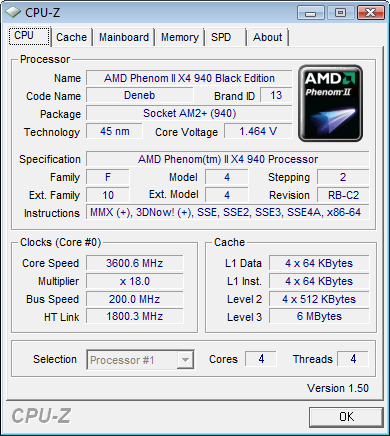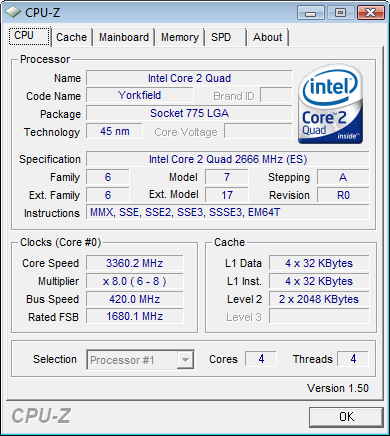The Core 2 Quad Q8400: Intel's $183 Phenom II 940 Competitor
by Anand Lal Shimpi on May 7, 2009 12:00 AM EST- Posted in
- CPUs
Overclocking with a 10% Increase in Core Voltage
While there's something nice about not having to do anything to overclock your CPU other than adjusting a single parameter, tweaking your core voltage has the potential to significantly increase your overclocking potential.
Let's start with the Phenom II X4 940. Using the stock AMD cooler and pushing a max 10% increase in core voltage we ended up with 3.6GHz and a 2.2GHz NB frequency at 1.475V:

I was able to get the chip up to 3.9GHz but not stable enough to complete all of my tests over a significant period of time. Still, a 20% overclock with a moderate increase in core voltage isn't bad at all.
The Core 2 Quad Q8400 saw a 15% increase in clock speed without touching the core voltage. Bumping the core voltage up to 1.45V bought us another 11% taking the chip up to 3.36GHz:

At 3.6GHz vs. 3.36GHz, AMD's clock speed advantage grows to ~7%. Not as big as the 12.7% clock speed advantage at stock frequencies but bigger than the 4% difference in our stock voltage OC attempt.
| Processor | Adobe Photoshop CS4 | x264 HD - 2nd pass | POV-Ray | Far Cry 2 | Idle Power | Load Power |
| AMD Phenom II X4 940 @ 3.6GHz | 20.3s | 21.3 fps | 2839 | 51.5 fps | 120.8W | 256W |
| Intel Core 2 Quad Q8400 @ 3.36GHz | 18.0s | 22.3 fps | 2771 | 59.5 fps | 139.9W | 213W |
At max overclock something interesting happens. Obviously the Q8400 holds on to the lead in Photoshop and Far Cry 2, but POV-Ray goes back to AMD. The x264 encode ends up being a mild victory by the Q8400. Far Cry 2 is bizzare as the Phenom II saw no performance improvement from 3.2GHz up to 3.6GHz, regardless of how many times I ran the test I could never get a higher frame rate out of the system - even with CnQ disabled.There must be some other bottleneck operating here, but it's not a GPU one since the Q8400 was able to scale all the way up to 59.5 fps with the same graphics card.
The situation seems to boil down to this - at max frequency the Phenom II will probably retain its performance lead in 3D rendering and ray-tracing applications, while the video encoding lead goes to Intel. Power consumption also favors the Q8400 significantly.










60 Comments
View All Comments
Scali - Friday, May 8, 2009 - link
I was already considering XP mode in my earlier post.I don't think that will be a big deal. Most people won't need it. Besides, you can still stick to XP or 32-bit Vista (not sure if 16-bit apps work in 32-bit Windows 7, else even that would be an option) if you have some applications that won't work in Win7. That way you don't need hardware virtualization either.
I don't think hypervisors are going to be a big deal for the majority of people, since they simply don't need any kind of virtualization to begin with. It may be interesting for servers and such, but not for your average office machine, of which there are FAR more in the world.
And for home users it won't be an issue anyway, because they generally won't even run a version of Windows 7 that supports XP Mode in the first place.
leexgx - Friday, May 8, 2009 - link
but with intel you have to Realy check what CPU you are getting to see if it does support VT as thay do not state fully if it has VT or not all the time (not from the Q8x00 model any way) where as you get sempron it has no AMD-v get an norm AMD64 it has AMD-v that simpleshould never be turnd off realy its only been turnd off in the first place all of there cpus support VT (q8x00 i think is the exception as none of them have the VT option)
Scali - Friday, May 8, 2009 - link
I'd like to comment on the closing statement of the article.I don't like the idea of supporting a company that has failed to deliver the goods for a few years now. It seems like AMD has dug a hole so deep that it's impossible to get out of it now. Buying AMD products isn't going to bring competition back. People ARE buying AMD products because they have such low prices (recently AMD has taken back some marketshare from Intel), but because of the low prices AMD just doesnt' bring in enough money. This also means they won't have a good budget for developing more competitive products in the future.
In my opinion it seems AMD has already lost. They made two mistakes:
1) They completely underestimated Intel and didn't do enough to prepare for Intel's Core2 back when AMD was still performance leader with the K7/K8 and was on top of its game.
2) Their acquisition of ATi was ill-informed. They paid way too much for that company, and they seem to have purchased it at the worst possible time.
This has weakened AMD so badly that it seems inevitable that they go bankrupt... The question is just: when.
just4U - Saturday, May 9, 2009 - link
I disagree with you on this. How was AMD able to "do enough" when they were the performance leader? It's not like they were making boat loads of money. Intel was. Didn't seem to matter that the P4 sucked in comparison they just kept on keeping on.That was due in part, to interesting business deals that Intel made to keep Amd down (or so the lawsuits say) but the juries still out on all that (just thought I'd note it)
I don't really see AMD making mistakes at all right now. They've got a nice lineup of video cards, and Cpu's that are in price brackets where the bulk of hardware is being sold. It will be interesting to see if they can build some momentum from it and hopefully it's not to little to late!
Scali - Sunday, May 10, 2009 - link
Well, if you're performance leader, you have to milk that position.For starters, AMD didn't do enough to market their processors. As you say, P4 sales just kept going. Probably for a large part because most people didn't even know about the Athlons anyway, or had no idea about how fast they were.
Then you also have to make sure you bring in the money by selling the right products at the right prices. And then you have to invest your profits into better production facilities and future products.
After the success of K8, the K10 is a pretty mediocre CPU. It's little more than two K8s joined together, with some L3-cache, and some minor architectural changes. Now either AMD just didn't put enough effort into designing a newer architecture, because they thought K8 was going to keep Intel off for years... or they just made the wrong decisions, screwed up (K9?), and then had to redo the design, wasting a lot of money, and coming up with a product that was much delayed, and far less spectacular than they would have hoped.
Either way, AMD should have done better with the K8's successor. They didn't, and that's why they are where they are right now.
lef - Friday, May 8, 2009 - link
i can overclock my 940 just by setting the multiplier at 17x to 3400 with stock voltage (asus m3a79-t) at 2 seconds and you could only do 16x 3200?. what's the matter with you guys? are you incompetent or you are just misleading people here?Anand Lal Shimpi - Friday, May 8, 2009 - link
Our Phenom II X4 940 was not stable enough to run through all of our tests at 3.4GHz without additional voltage. Remember that when overclocking your mileage may vary. We saw the same 3.2GHz limit without increasing the stock voltage on our other 940 when we first reviewed the chips back in January.It is possible that later productions are more overclockable and as we all know the Phenom II X4 955 does much better at stock voltages than any of the AM2+ parts we'd seen up to that point. It's really a question of whether or not AMD is focused on producing more 940s or will production eventually shift over to 945s entirely. If it's the latter, I don't expect stock voltage overclocking to improve much more on the 940. If it's the former, then the 940 should eventually be as good as the newer AM3 parts for overclocking.
Take care,
Anand
sluk - Friday, May 8, 2009 - link
Developer of VirtualBox (Sun Microsystems) claimed that hardware accelerated virtualization in fact perform slower than software virtualization. I wonder if there is any 3rd party benchmark test can confirm this or if it is only true for Virtualbox. If this is the case, why you need to care about VT support in CPU, you can just run your XP virtual machine with any type of CPU in Windows 7.stmok - Sunday, May 10, 2009 - link
It isn't so straightforward.The first generation of VT support in CPUs really benefits the software developer. It makes it easier for them to implement a robust virtualization environment. It isn't primarily about performance. (The gain is very little).
The 2nd generation with features like nested paging are. But that is only in Phenom I/II and Core i5/7 generations.
It leads me to believe Microsoft was scrambling to address the WinXP compatibility issues with custom business software in Windows 7.
Software using hardware virtualization is far easier to develop. (They have a deadline to meet, as well as customer expectations).
DeepThought86 - Thursday, May 7, 2009 - link
Ummmm, how can we assume that wafer costs are the main costs associated with CPU production? Both AMD and Intel have already invested billions in fab construction, fab equipment, researcher salaries, marketing budgets, admin staff etc etc.To say that after all that what's killing AMD is the costs of the wafers is plain silly. Sure, it's a higher variable cost. But what proportion are variable costs compared to fixed costs? If AMD stopped selling Semprons and X2s and shifted their production to 100% Phenom II 2.5 GHzs, would their costs go up significantly compared to the losses they've been making?